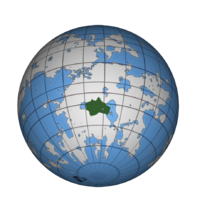Encessia
The Auteker of Encessia ენცეზია | |
|---|---|
| Motto: "ღმერთმა დაიცვას ჩვენი ერთიანობა" God preserve our unity | |
| Anthem: “მაღალმთიანთა ერი” | |
 Location of Encessia in Thrismari | |
| Capital | Samepo |
| Largest city | Potia |
| Official languages | Encessi |
| Recognised national languages | Skythean, Urozakian |
| Recognised regional languages | Abjekh, Arabic |
| Ethnic groups (c. 2020) |
|
| Religion |
|
| Demonym(s) | Encessian |
| Government | Constitutional Dictatorship (Auteker) |
• Autek | Aleksandre Beridze |
| Establishment | |
• Unification of Skythea and Anteba | ab. 700 AD |
• Conquest of Urozakia | ab. 800 AD |
• Dissolution of the Kingdom of Anteba | 1890 |
• Formation of the First Republic | 1927 |
• Autekrat control and dissolution of the First Republic | 1989 |
• Establishment of the Auteker | 1994 |
| Population | |
• 2018 census | 62.2 million |
• Density | 92.4/km2 (239.3/sq mi) |
| GDP (nominal) | 2018 estimate |
• Total | 1.2 trillion ACU |
• Per capita | 19,292 ACU |
| Gini (2018) | low |
| HDI (2020) | very high |
| Currency | cenka (ц) |
| Time zone | GMT-2, GMT-3 |
| Driving side | right |
| Calling code | +77 |
| Internet TLD | .en |
Encessia (Encessi: ენცეზია, romanized: "Entsezia") is a country located in central Thrismari. It is bounded to the east by the Marmor Sea, and bordered by Abjekistan to the northwest and South Eissenau to the south. The capital is Samepo, and the largest city is Potia. Its population is about 62.2 million, and is ruled by a limited dictatorship with military authority. Encessia is a popular tourist destination due to its extensive and old history, known for its medieval castles, beautiful natural mountains, and ancient wine and cheesemaking traditions. It is popular with foreign nations for its copper and lithium production, accompanied with a healthy oil industry and large agriculture sector mainly focused in the south.
During the classical era the main force to dominate the Encessian highlands were the Skytheans, an ethnic group and national identity that spoke Skythean, a member of the Kartvelyn language family. They conflicted with their northern neighbors, the Urozakians, before the Skytheans overran their land and integrated them into the loose empire. By 200 AD the Skythean empire stretched across the deserts and steppes of central Thrismari, and raided its neighbors to maintain itself- and integrated into surrounding nations to expand the Skythean culture and influence. In about 600 AD Encessians migrated into the highlands from the south after being exiled from modern-day South Eissenau by Germanic counterparts. They settled along the fertile valleys and foothills of the Narinjisperi mountains, and soon had established their own nation known as classical Anteba. The Skytheans had attempted to subdue and assimilate the Encessians, but in the following wars they were driven back into the Hilajhi Basin by the Encessians who utilized advanced methods of metals and metalworking. As Skythea fell from power the kingdom of Anteba would take its place, establishing itself as the dominant power of the region into the Middle Ages. Under King Abramishvili the kingdom of Anteba would begin military conquests against the rump Skythean state and Urozakia to the north, bringing them under the banner of Anteba around 1198-1207. He would rename Anteba to Encessia, meaning 'land of Encessians' in Encessi. Encessia would reach the peak of its power and prosperity around this time, becoming a dominant power in central Thrismari and being home to many advancements and revolutions during the Middle Ages. It is thought Encessia's power reached its highest under King Abramishvili IV in 1311 which hosted the beginning of an explosive golden age that followed for years after.
It wasn't until 1887 that the Kingdom would fall after years of oppressive leadership, stagnation, and increased nationalism amongst the minority groups of the nation. In 1890 Encessia would dissolve into the states of Khretiabjekh, Skythea, Urozakia, and Anteba once more. Only in 1927 did a Republic form between the separate entities, dominated by the Encessians who outnumbered the other ethnic groups greatly. The Republic however was weak, and failed to provide stability or modernization. Despite these insecurities the Republic still went on to occupy and colonize the Marsev Islands in 1933 in an effort to expand industry on new fronts. In 1977 a group known as the 'Autekrats' assumed political majority in the Republic, and under their authoritarian yet progressive ideals they spurred the nation forward to the modern world- but conflicted with the Left Republicans and Monarchists both. In 1989 the monarchists attempted to overthrow the Republic, starting a civil war that would last for four years. The Autekrats and Left Republicans allied to fight back the Monarchists, and concluded the war with victory in their favor. However with majority support of the people the Autekrats declared the dissolution of the First Republic, which antagonized the Republicans who soon after attempted a coup of their own that was swiftly crushed. Autek Beridze rose to power, a famous and experienced general from the war, and established a constitutional dictatorship in an action of emergency. Placing the Autekrats in power to this very day. Encessia is a developing country, with a 'very high' HDI of 0.844.
Etymology
The word Encessia quite literally means "land of the Encessians" in the dead Anteban dialect of Encessian. The first usage of Encessia stems from the Skythean word for wolf, Uncez. In the classical ages Anteba was referred to by the Skytheans as Uncezia, meaning "land of the wolves". Later Urozakians also began to refer to Anteba as this name, and medieval Urozakian geographer was one of the first to accurately map central Thrismari and when doing so bestowed Anteba the name Uncezia. The first wide foreign usage of this name would follow, and after the unification of the Kingdom the Anteban dialects would assimilate both Urozakian and Skythean elements and form the modern version of Encessia. In these dialects Uncezia slowly changed to Encessia over the years. The first spelling of Encessia can be found in Kentalian explorer Vlado Hristov's maps of Thrismari after he inquired the locals on the name of their kingdom. In 1927 after the dissolution of the Kingdom and the establishment of the First Republic Anteba was modernized and referred to as Encessia as a more true term for the three states that made up the nation, officially installing the name of Encessia.
History
Government and Politics
Administrative Divisions
Geography
Economy
Transportation
Demographics
Culture
Politics
Diplomacy and Foreign Relations
Encessia throughout history had remained a relative regional power and fairly isolated nation relying on a series of vassal states and trade cities within the immediate area. After the spread of Christianity the expansion of Encessian influence was heavily reliant on the expansion of the Eastern Orthodox church throughout the High Middle Ages. It wasn't until the Age of Exploration and the dawn of the 19th century that Encessia capitulated to the world stage, after newfound independence and later involvement in the Great War (Anteria). In the mid 20th century the First Republic established official and worldwide foreign relations with globalism in mind- however after the Autekrat revolution and rise to power many of these relations stagnated. The Auteker retains a worldwide diplomacy yet tends to oppose globalism and retains alliances and treaties with select few nations in their moderate isolationist stance.
Astariax
| Country | Formal Relations Began | Notes |
|---|---|---|
Caleren
| Country | Formal Relations Began | Notes |
|---|---|---|
Thuadia
| Country | Formal Relations Began | Notes |
|---|---|---|
Thrismari
| Country | Formal Relations Began | Notes |
|---|---|---|
| 1949 |
| |
Merdonne
| Country | Formal Relations Began | Notes |
|---|---|---|
Olivacia
| Country | Formal Relations Began | Notes |
|---|---|---|

